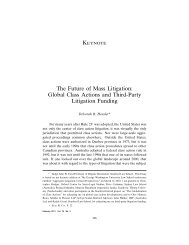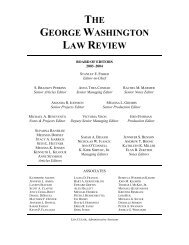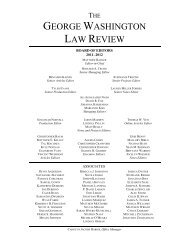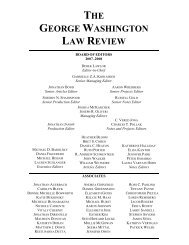View PDF - The George Washington Law Review
View PDF - The George Washington Law Review
View PDF - The George Washington Law Review
Create successful ePaper yourself
Turn your PDF publications into a flip-book with our unique Google optimized e-Paper software.
8 THE GEORGE WASHINGTON LAW REVIEWARGUENDO [Vol. 82<br />
Judge Scheindlin believed that Kelly’s statement reflected racial animus. 37<br />
She also found significant the City’s failure to have Kelly testify at trial in<br />
order to offer a benign explanation for that remark. 38 That tactical decision,<br />
which the City may now regret, allowed the judge to draw an adverse inference<br />
that Kelly’s testimony would have been unfavorable. 39 Those two<br />
factors, atop the other evidence in the case, persuaded her that the City had<br />
acted with impermissible racial animus. 40<br />
If a senior New York City official tacitly adopted and directed the<br />
NYPD to pursue a racially tainted stop-and-frisk policy, then, given the<br />
large number of blacks and Hispanics stopped, it would be reasonable to<br />
conclude that impermissible racial considerations affected patrol officers’<br />
decisions to conduct a stop and frisk in a nontrivial number of cases. <strong>The</strong><br />
appropriate remedy would be to forbid reliance on any such policy, to discipline<br />
the appropriate city officials—within or outside of the NYPD—who<br />
adopted that policy or encouraged it to be used, and to oversee for a limited<br />
period of time how the NYPD responds. <strong>The</strong>re would be no need to analyze<br />
the constitutionality of each police-citizen encounter under the Fourth<br />
Amendment in order to provide relief to the plaintiffs.<br />
III. RACE AND LAW ENFORCEMENT<br />
When the government can use race as a legitimate criterion in law enforcement<br />
decisionmaking is a tricky issue. It is clear, however, that there<br />
are times when the government may do so. For example, the government<br />
can use an undercover African American police officer, instead of a Son of<br />
the Old Sod, when trying to infiltrate a Jamaican drug posse. <strong>The</strong> converse<br />
is true when investigating the Irish Republican Army. Few would disagree<br />
with those propositions. <strong>The</strong> difficulty arises when the government uses<br />
race, not as a basis for selecting law enforcement officers for specialized<br />
tasks, but when selecting members of the public for coercive scrutiny.<br />
Floyd raises the question of what role, if any, race can play in making<br />
the decision to stop or frisk a person. Sometimes it may. Race can be used<br />
as one of several identifying factors in deciding whether reasonable suspicion<br />
exists to believe that a particular individual has committed, is committing,<br />
or is about to commit a crime. 41 On one end of the spectrum, the Fed-<br />
37 See id.<br />
38 Id. at *73.<br />
39 See, e.g., Interstate Circuit, Inc. v. United States, 306 U.S. 208, 225–26 (1939)<br />
(holding that the trier of fact may draw an adverse inference from a party’s failure to present<br />
testimony from a relevant witness).<br />
40 Floyd, 2013 WL 4046209, at *5, *24.<br />
41 See, e.g., Brown v. City of Oneonta, 221 F.3d 329, 337–38 (2d Cir. 2000) (“In act-









